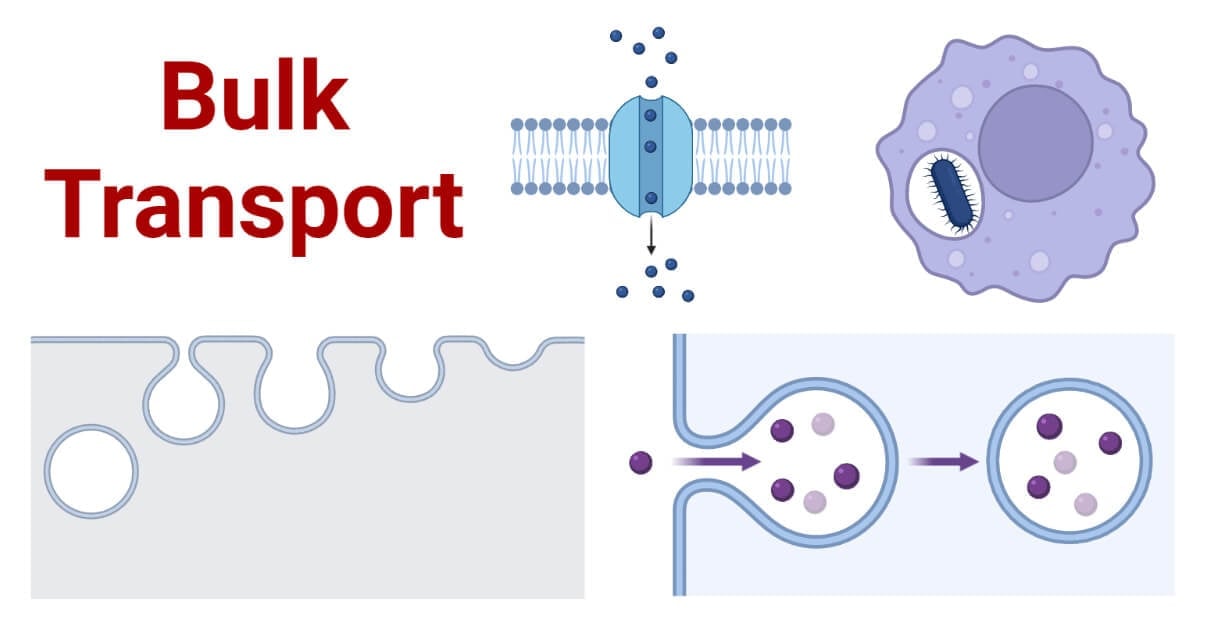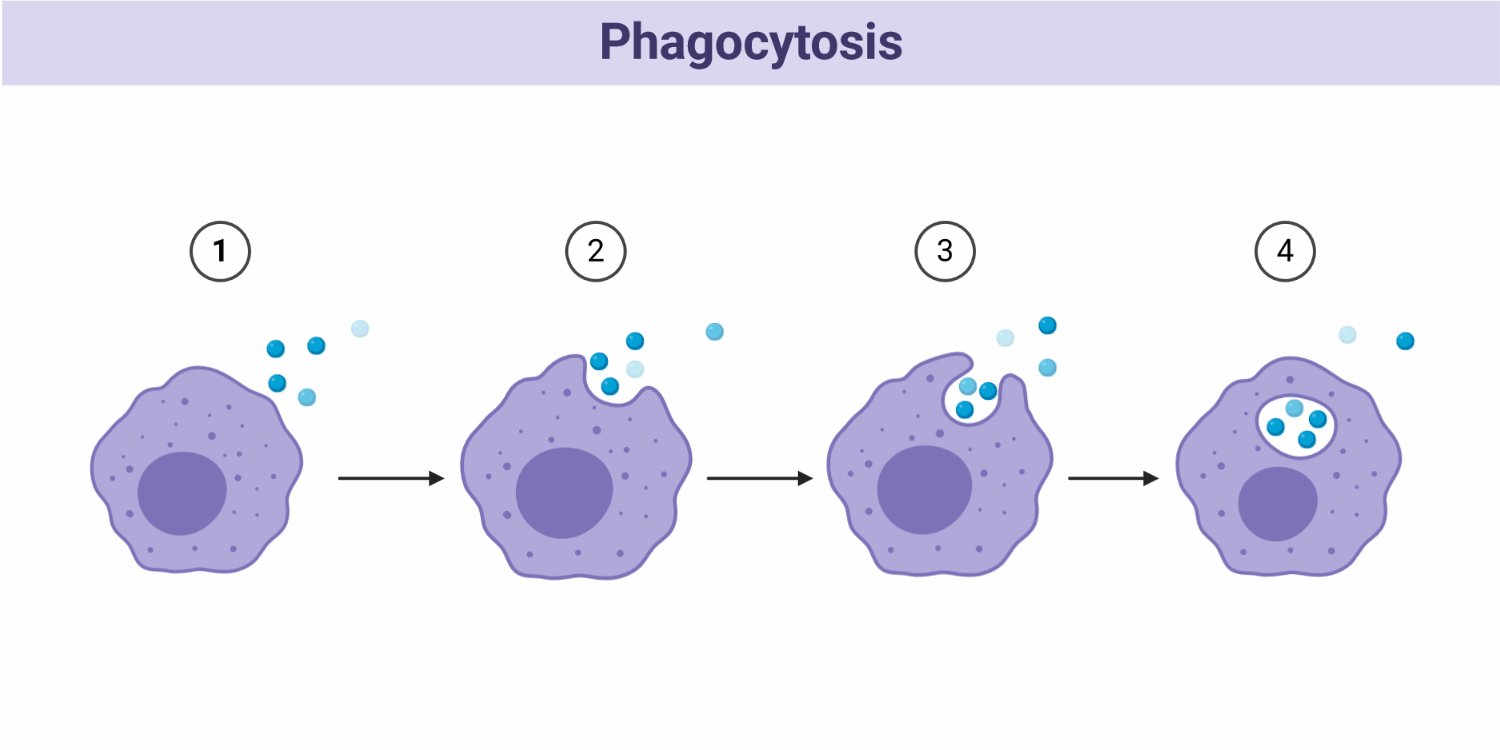Bulk Transport is a cellular process by which large amounts of material are transported in or out of the cell in membrane-bound sacs called cysts.
The membrane is held together by weak hydrophobic associations between fatty acid tails by phospholipids. Besides, the weak association allows for membrane fluidity and flexibility as the phospholipids move around.

Bulk transport allows for the breaking and reforming of the bilayer, allowing more extensive materials to enter or leave the cell without crossing the membrane. It is an active process requiring ATP hydrolysis.
Further, this process is necessary for various biological functions, including the uptake of nutrients, removal of waste, secretion of hormones, and communication between cells.
Interesting Science Videos
Importance of Bulk Transport in Biology
In terms of plants or animals, bulk transport plays a crucial role in the transportation of materials across the membranes. Moreover, cells need to have a high demand for specific molecules like signaling molecules which are hard to diffuse across the cell membrane due to their size or charge.
Bulk transport also helps maintain the balance of ions and molecules inside and outside the cell. It removes waste and toxins from the cell—furthermore, bulk transport aids in properly functioning a multicellular organism.
According to the National Institute of Health, signaling molecule controls the whole body and are called hormones. It is secreted by the signaling cells that carry the signal to the target cells distributed throughout the body.
Overall, bulk transport allows us to perform essential functions, maintain homeostasis, and communicate with other cells in the body.
Types of Bulk Transport
An engulfing of macrophages can be an example of bulk transport, but some cells in the body don’t engulf the whole microorganism. However, the truth cannot be denied that the cells in our body perform bulk transport mechanisms of some kind.
It actively transports the ions and small molecules via carrier protein, an energy-intensive process. There are two main types of bulk transport: endocytosis, which involves the uptake of materials into the cell, and Exocytosis, which consists of releasing materials from the cell.
Endocytosis
The channel proteins discuss in the preceding section transport small molecules through the phospholipid layer. Endocytosis engulfs the macromolecules and particles from the surrounding medium by a eukaryotic cell.
The term “endocytosis” was coined by Christian deDuve in 1963 to include ingesting large particles (such as bacteria) and the uptake of fluids or macromolecules in small vesicles.
Further, in endocytosis, the material to be internalized is surrounded by an area of the plasma membrane, which then buds off inside the cell to form a vesicle containing the ingested material.
Types of Endocytosis
Endocytosis internalizes large extracellular proteins, insoluble particles, or even tiny microorganisms. Further, there are three types of endocytosis phagocytosis, pinocytosis, and receptor-mediated endocytosis.
a. Phagocytosis
Phagocytosis is a form of endocytosis that involves submerging large particles. It allows immune cells like macrophages to eliminate bacteria, cancer cells, and viruses.
Further, it is also a process by which organisms such as amoebas obtain food from the surrounding. In Phagocytosis, the phagocyte must be able to attach to the target cell, internalize, degrade, and expel the refuse.

b. Pinocytosis
Phagocytosis involves cell eating, while pinocytosis involves cell drinking. Simply put, it is a nonspecific more or less pinching off small vesicle engulfing extracellular fluid containing solute (as it is too small to include significant particulates).
Pinocytosis takes fluid and dissolved nutrients into a cell, utilizing the basic steps of endocytosis.
c. Receptor-mediated Endocytosis
Receptor-mediated endocytosis is ideal for bringing more significant substances into cells. This endocytosis process relies on receptors’ affinity for specific extracellular substances. The binding ligands of the receptors aggregate in differentiated regions of the cell membranes called coated pits.
Furthermore, receptor-mediated endocytosis intends to bring valuable substances into the cell, and less friendly particles may gain entry by the same route.
Flu viruses, diphtheria, and cholera toxin use receptor-mediated endocytosis pathways to enter the cells.
Exocytosis
Exocytosis is the fusion of the secretory vesicles with the plasma membrane. It results in the discharge of vesicle content into the extracellular space, and new proteins and lipids are incorporated into the plasma membrane.
It can be consecutive or regulated cells like neurons, endocrine and exocrine cells that release material from the cell.
The Golgi apparatus, endosomes, and pre-synaptic neurons form exocytotic vesicles.
Golgi apparatus contains proteins made by the cell released outside, such as signaling molecules. Besides, other vesicles contain wastes the cell needs to dispose of, such as the leftovers after a phagocytosed particle is digested.
Types of Exocytosis
Exocyotis have three common pathways: constitutive exocytosis, regulated exocytosis, and lysosome-mediated exocytosis.
a. Constitutive Exocytosis
Constitutive Exocytosis involves the action performed by cells that helps in the secretion of molecules. Further, it delivers membrane proteins and lipids to the cell’s surface and expels substances to the cell exterior.
It occurs in cells continuously and is also responsible for the secretion of proteins and lipids into the extracellular space.
Fun Fact: Constitutive Exocytosis requires no external stimuli and is considered a default secretion pathway.
b. Regulated Exocytosis
Regulated Exocytosis depends on extracellular signals for the explosions of materials within vesicles. At the same time, this process occurs only in secretory cells and not in all types of cells.
Secretory cells store products such as neurotransmitters, hormones, and digestive enzymes that are released only when triggered by extracellular signals. Moreover, secretory vesicles are not incorporated into the cell membrane but fuse only long enough to remove their content.
After the product is delivered, the vesicles reform, returning to the cytoplasm. Regulated Exocytosis can be further divided into Ca2+-dependent Exocytosis and Ca2+-independent Exocytosis.
c. Lysosome-mediated Exocytosis
Lysosome-mediated Exocytosis involves the fusion of vesicles with lysosomes which breaks waste materials, microbes, and cellular debris with the help of acid hydrolase enzymes present in lysosomes. Then Lysosome transports the digested materials to the cell membrane and then outside of the cell (extracellular matrix). Lysosome-mediated Exocytosis is a Ca2+-dependent process.
Conclusion
Bulk transport is a vital biological process that allows the movement of large quantities of substances, such as nutrients, water, and waste products, across cell membranes and through organisms.
Various modes of bulk transportation, like Exocytosis and endocytosis, have their respective function for the proper functioning of our body.
Overall, bulk transport is a fascinating and complex process that plays a critical role in the survival and function of biological organisms.
Reference
- http://ib.bioninja.com.au/standard-level/topic-1-cell-biology/14-membrane-transport/bulk-transport.html
- https://www.khanacademy.org/science/ap-biology/cell-structure-and-function/membrane-transport/a/bulk-transport
- https://pressbooks-dev.oer.hawaii.edu/biology/chapter/bulk-transport/
- https://pubs.acs.org/doi/abs/10.1021/la0622875
- https://www.tandfonline.com/doi/abs/10.1080/10408347.2015.1064759
- https://pubs.acs.org/doi/pdf/10.1021/ac50019a027
- https://www.annualreviews.org/doi/abs/10.1146/annurev.biochem.78.081307.110540
- https://www.annualreviews.org/doi/abs/10.1146/annurev.cellbio.12.1.575
- https://academic.oup.com/plcell/article-abstract/11/4/643/6008491
